
L & M Compost turns liability into a profitable composting operation
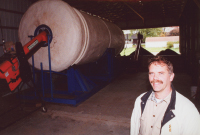 |
| Mike Bronkema uses a model 824 that processes approximately eight yards of product a day. The rotating drum continually aerates and prevents uneven pockets during the composting process. |
L & M Compost turns liability into a profitable composting operation
Not everyone can transition from construction worker to chicken farmer and commercial compost producer. But Mike Bronkema did just that in 1992.
Bronkema’s family farm is located on 160 acres in Holland, Mich. The family of six raises pullets — between 52,000 and 58,000 per batch every 17 weeks. They also raise 150 head of sheep and grow corn, soybeans, hay and oats.
In 1996, when Mike expanded the pullet operation, he ran into manure issues. “We were producing enough manure for well over 400 acres of ground,” he says. “With 160 acres available, we had to find another way to manage manure because we were exceeding our phosphorous limits.”
He tried hauling the manure to other locations, but that was problematic because the farm sits between two cities, roughly 20 miles apart. The semi-liquid manure sometimes dripped onto the road “and nobody likes that,” says Mike.
In 1998, the farm family made the decision to move to composting. After raising money, jumping through hoops and educating officials, they installed a BW Organic in-vessel compost system in 2000.
Money, hoops and education
Grants helped pay for a large portion of the project. Equipment grants came from the Natural Resource Conservation Service (NRCS) but to be eligible the Bronkemas had to incorporate a number of environmental practices, including driveways, filter strips, and storm water runoff, among others.
The drum was secured through a low interest rate loan from the Michigan Department of Environmental Quality. “And working with two departments — the Michigan Department of Ag and the Department of Environmental Quality (DEQ) —we had quite a bit of regulation to work around.”
The Bronkemas were able to save a lot of money doing the work themselves, and Mike’s construction background came in extremely handy.
One of the frustrations, however, was educating the DEQ, as this was the first working composting endeavor they had worked through.
“They initially wanted to license us as a landfill,” Mike says. “We had done enough testing with the final product though to show their issues disappeared in the composting process.”
Another issue the DEQ had was with the sawdust Mike was adding that came from a local furniture maker. Mike had to demonstrate that the sawdust contained no harmful chemicals.
One of the biggest frustrations, however, was when the DEQ said they didn’t like the amount of iron that was coming through from the manure. “All of a sudden we had an issue with a micronutrient that farmers use to grow crops,” says Mike, “They were saying it was an environmental issue and that it had to go to a landfill. So we had to educate them as to the difference between a waste product and a fertilizer.”
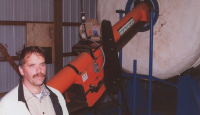 |
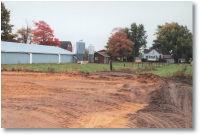
|
| The composting unit is eight feet in diameter and 24 feet long and is rotated by a 1.5-hp, 230-volt electric motor. Manure is composted for 72 hours (three days), and then removed easily from three slide-gate unloading doors. | In 2006 the Michigan Farm Bureau recognized the Bronkema farm for proactive leadership in ecology management. In 2007, the American Sheep Industry gave the operation the Environmental Stewardship Award. |
Composting at last
It was worth jumping through the hoops. Now the Bronkemas have an in-vessel system of composting that allows them to compost year-round.
“We can start the composting process in the winter, get through the main part of composting, which is the thermophilic stage, and then be able to stockpile it on a pad for application in the spring or fall,” says Mike. “It turned manure in to a value added product to us.”
A big vessel
Mike installed a model 824 — one of BW Organics’ mid-sized models. It processes approximately eight yards of product a day. The rotating drum continually aerates and prevents uneven pockets during the composting process. The unit is mounted on an eight-inch I-beam frame with a slope built into the casters.
The insulated drum is eight feet in diameter and 24 feet long and is rotated by a 1.5-hp, 230-volt electric motor, which Mike says costs him about $3.50 a day to operate. Manure is composted for 72 hours (three days), and then removed easily from three slide-gate unloading doors.
Mike says one of the reasons he’s able to add eight yards a day is because he’s using a product that’s easy to compost. Other products may take more time.
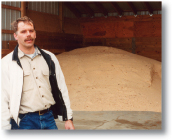 |
| A compost batch is composed of several ingredients, including 1,000 pounds of sawdust, 40 pounds of straw, and 3,000 pounds of chicken manure. |
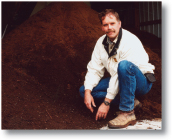 |
| The compost is taken from the drum to an outdoor 100-foot by 100-foot gravel curing pad, designed to hold six months’ worth of composted manure. The compost remains on the slab for six months. |
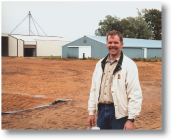 |
| Bronkema family farm is located on 160 acres in Holland, Mich. The family of six raises pullets — between 52,000 and 58,000 per batch every 17 weeks. They also raise 150 head of sheep and grow corn, soybeans, hay and oats. |
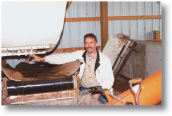 |
| Each day, Mike Bronkema mixes a new batch of ingredients for the composter. The manure sits there in the mixer wagon overnight with the temperature ramping up. In the summer it can go from an ambient temperature in the evening up to about 110 (degrees Fahrenheit) the next morning. |
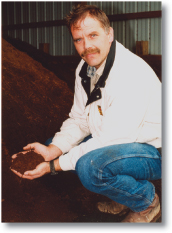 |
| The price of compost has steadily been increasing since the day the Bronkema family went into the business. At first, they were getting $10 to $15 a yard while it cost $8.50 to produce. Today, even using a broker, the farm operation receives $17 a yard. |
Compost broker
Mike initially sold the compost himself, but eventually turned to
another composting farmer, Brad Morgan of Morgan Composting in Everett,
Mich., who acts as his broker. “He moves my compost all over the state
of Michigan, which is great,” says Mike. “And that allows me to spend
more time raising my animals.”
Fortunately for Mike, the price of compost has steadily been increasing
since the day he went into the business. At first, he was getting $10
to $15 a yard while it cost $8.50 to produce. Today, even using a
broker, he’s getting $17 a yard.
The process
The Bronkemas’ pullets create more manure than the operation can process at times. While it can take up to two weeks before the chicks are producing enough manure to process, by the end of their 17-week stay, they will have produced around 450 yards.
“As the chicks get older, we almost have to stockpile it or find a small site off site,” says Mike. “I’ve found a secondary composter that will use my extras throughout the year.
“Depending on how much moisture there in, among other things, we can compost up to 90 percent of the manure on site.”
Manure is collected from underneath the birds with custom-made scrapers designed for the 42-foot by 270-foot pullet barn. The manure is then placed in a Knight 2250 mixer wagon.
“The mixed compost is all measured by scale when we start,” says Mike.
He feeds the drum a “batch” and a half each day. A batch is composed of several ingredients. “We use 1,000 pounds of sawdust. We also like to add about 40 pounds of straw, which sometimes comes from our sheep barn. It adds a little manure to the mix, but generally doesn’t change our carbon to nitrogen ratio.” Lastly he adds 3,000 pounds of chicken manure.
He finishes each day by mixing a new batch. “I mix compost or fill the mixer wagon with manure and sawdust,” says Mike. “The manure sits there in the mixer wagon overnight with the temperature ramping up. In the summer it can go from an ambient temperature in the evening up to about 110 (degrees Fahrenheit) the next morning.”
The composter is located in a 24-foot by 100-foot open barn, and is fed several times over the course of an hour. The compost will spend 72 hours in the drum at a minimum of 131 degrees Fahrenheit — the temperature and time required to kill the pathogens. In the summer, however, the temperature in the drum can get high as 140 to 144 degrees Fahrenheit.
From drum to dollars
The compost is taken from the drum to an outdoor 100-foot by 100-foot gravel curing pad, designed to hold six months’ worth of composted manure.
The pad has a three percent slope. “Any water runoff goes through a 50-foot by 160-foot grass filter before it reaches the fields.”
Mike’s pleased with the efficiency of the system. “We’re able to manage the water runoff on the mat, catching the nutrients and harvesting them in the form of hay that is then been fed back to the sheep,” he says.
The compost remains on the slab for six months. “We generally put the compost on one side of the pad and then roll it across the pad, because it needs occasional turnings for it to get oxygen for the composting process,” explains Mike. “By the time it gets across the pad in six months, it’s generally at an ambient outdoor temperature.” And ready for sale.
Plant health
Mike has been using the compost on his own fields now that they are at a healthy phosphorous level. He’s noticed since they started using their compost they’ve experienced healthier plants.
“With healthier plants, my animals are actually healthier, so we have less medical problems,” says Mike. “After eight years of composting I’m starting to realize what composting means to the environment. Instead of just a way to handle the manure, it means something to me in that it goes into my animals.
“Now if I’ve got healthy animals, what’s that gonna do for me?” Mike adds. “If I’m eating my animals, I should be healthier too, right?”
See the benefits
Agencies, companies and individuals are becoming more compost savvy. For example, Mike says that Michigan law has just changed, allowing mortality composting in a vessel system rather than just a static pile.
“The nice thing about the vessel system in doing mortality is that we get rid of all soft tissue in about three days in the unit,” says Mike. “It’s really the best way to get rid of mortalities.”
And even the DEQ is coming around. “We started out with skeptics in the DEQ that really didn’t even want composting. Now they are coming around asking us about the composting process.”
Good investment
Mike is a true believer in compost. It’s not only been a sound environmental decision, but a good business decision as well.
“I spend the same amount of time I was spending loading manure into the manure spreader and transporting it to outlying fields as I do making compost,” he says. “The big difference is I’m getting money for the manure.
And he’s getting all the benefits from the nutrients. “Compost holds nutrients. It makes the nutrients available to the plants and animals in a way that they can use them,” says Mike.
He says you lose more nutrients spreading straight manure. “When you start putting compost out there, you hold your nutrients. All of a sudden you go from a welfare-type soil system to a working-based nutrient system in the soil.”
Recognition
Mike has reason to be proud of his farm. Many have praised the family’s efforts. In 2006 the Michigan Farm Bureau recognized them for proactive leadership in ecology management. In 2007, the American Sheep Industry gave them the Environmental Stewardship Award. And there have been others awards for their manure management.
“I guess I love compost,” says Mike. “The more I learn about compost, I see how it completes the life cycle.”